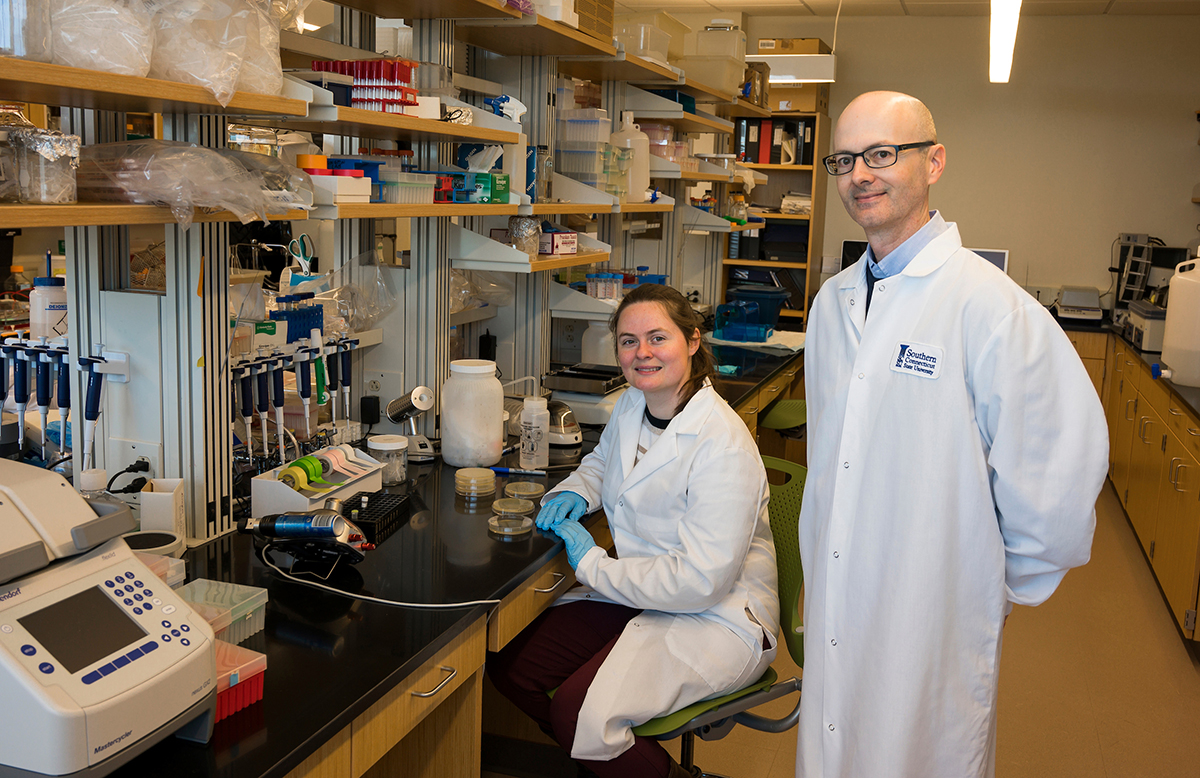Students enrolled in biotechnology — applied molecular and cellular biology — at Southern Connecticut State University get their hands dirty. No, really. Part of the required learning for the B.S. in biotechnology is to dig in the dirt.
“We’re looking for phages,” explains Nicholas Edgington, associate professor and biotech program coordinator. “In the ground.”
A “phage” is short for bacteriophage, and a bacteriophage is a virus that infects and replicates within bacteria. In simple terms, finding phages is important because it enables students to discover new bacteria-killing viruses.
Southern’s phage hunting course, SEA-PHAGES (Science Education Alliance-Phage Hunters Advancing Genomics and Evolutionary Science), starts with simple digging in the soil to find new viruses and progresses through a variety of microbiology techniques to complex genome annotation and bioinformatic analyses. The two-semester course is embedded into Genomics I and II and is one of two innovative national educational programs that are part of the degree and give students hands-on access to real world health threats. The other program, Small World Initiative, or SWI, requires students to roll up their sleeves and get digging again — this time for antibiotic-producing bacteria. SWI seeks to address the problem of antibiotic resistant “superbugs” or bacteria, by having students isolate soil microorganisms that may produce new antimicrobial products.
Southern student Amelia Hoyt’s eyes light up when she talks about the courses.
“Small World and SEA-PHAGES are actual research projects that had a huge impact on my education,” she says. “SEA-PHAGES is a really interesting class. You get to work with viral particles — viruses that affect bacteria.”
A self-described science enthusiastic — “I always enjoyed learning about science, especially the scientific discovery process and scientific research” — Hoyt quickly launches into the how-to process: “You take a soil sample and you grow it in media for a while and you inoculate the soil with host bacteria. Then you filter out the dirt and bacteria and what you’re left with is liquid full of virus particles, and you can take a sample of the liquid and you mix it in with cells from the host and then plate a lawn of that bacteria, and if a virus attaches it creates a plaque. It’s real lab work.”
So real, in fact, that the students’ findings are presented at regional symposiums and national conferences and are published in peer-reviewed research journals like Microbiology Resource Announcements and Nature Microbiology, as well as scientific databases like PhagesDB.org and the NCBI’s GenBank. Southern has 15 genomes published in GenBank with students as authors.
In addition to the dirt extracting courses, biotech students also participate in a required internship at a local company such as Alexion, Isoplexis, Quantum BioPower, Synovel Laboratory, Archillion, and more. Hoyt interned at The Jackson Laboratory. Her research, conducted under the guidance of Dr. Julia Oh, focused on the microbiome, specifically the differences in the interaction between the microbiome and the immune system in people with chronic fatigue syndrome.
“We took gut samples, isolated the bacteria from them in different conditions, making sure we got a wide range of samples,” she says. “Once we have certain bacteria sorted out, we can do experiments on them. And once we have results, we’ll write a paper about the methods and the results, trying to create a systemic way to characterize microbiomes of patients. We can take a population and identify the characteristics, so we can say, ‘This bacteria causes chronic fatigue syndrome.’”
With her internship ending in May, it’s too soon for Hoyt to draw any scientific conclusions, but she’s not disappointed: “I got a job offer at The Jackson Laboratory, so I’ll be able to see it all the way through.”
Internships can often evolve into employment, and while Southern does maintain strong relationships with businesses in the biotech field, Edgington is quick to point out that the strength of the program and the student are ultimately what get them in the door.
“Southern has a close relationship with BioCT [an organization dedicated to growing the bioscience ecosystem in Connecticut],” Edgington says. “But these companies aren’t holding positions open for our students. We have relationships, but students still get employed on their own merits.”
Employment prospects in the field are good. According to the Smithsonian Science Education Center (SSEC), STEM (science, technology, engineering, and math) occupations out-earn non-STEM fields by 12 to 30 percent across all education levels, and STEM jobs have doubled as a proportion of all jobs.
“Biotech is just applying molecular biology to programs,” Edgington says. “It’s coming up with new drugs, new pathways for interactions, new disease states, genome sequencing and risk predictions for fetuses. It’s pretty rare to have two genomics courses in an undergraduate program, like Southern does, and genomics is exploding.”
Southern’s biotech program also offers bioinformatics, which is the science of collecting and analyzing complex biological data such as genetic codes. Much like genomics, the field is ripe with opportunity.
“Biotech students get experience with programming and biologic data sets,” Edgington says. “Companies can’t hire enough students in bioinformatics.”
Then, there’s the research. Antibiotic resistance and diseases such as chronic fatigue syndrome are just two examples of the endless applications of research in the biotech field. To a science-loving student like Hoyt, the thought is a cheery one.
“There’s so much work to be done on human biome,” she says, “we’ll never run out of research projects.”
Southern Connecticut State University’s biotech program is currently applying for accreditation from The American Society for Biochemistry and Molecular Biology (ASBMB), a nonprofit scientific and educational organization, for its genomics courses.


